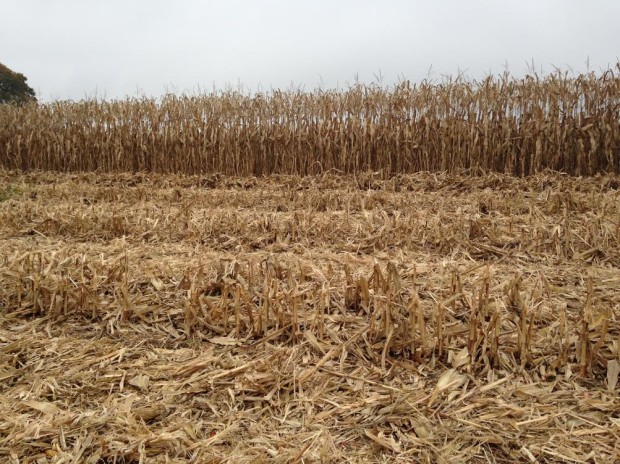We have much more to do and your continued support is needed now more than ever.
Can Corn Stover Really be a Sustainable Biofuel Source?
What are the best ways to help us replace our reliance on fossil fuels without causing unsustainable damage to land, climate, water, or wildlife?
The question remains unanswered because almost every means of energy production has both benefits and drawbacks, and biomass is no exception. A recent study by the University of Nebraska on biofuels produced from corn stover is currently receiving a lot of media attention, and raises the question: Can residue removal for biomass ever be sustainable?
Corn stover (corn plant material not harvested, primarily the leaves and stalk), is one way to reap some additional energy benefits from existing cropland. Residue removal has the potential to contribute to biofuel energy production without creating greater land use changes or adding significant energy costs. Some residue must be left on the ground to become beneficial organic matter and protect the soil from erosion; but some amount can be harvested and converted to cellulosic ethanol, which can be used as an alternative domestic energy source, decreasing reliance on fossil fuels.

Academic researchers and the biomass industry maintain that residue can be harvested sustainably, as long as it is removed at an appropriate rate specific to the location from which it is harvested. However, the study implies that it does not matter how much residue is removed; at any level, the greenhouse gas emissions are not justified by the amount of energy produced. The amount of carbon emissions in their life cycle analysis is divided by the bioenergy yield, and the yield decreases along with the amount of residue harvested.
Does this mean residue removal for energy is a lost cause? Not necessarily. The study points out that the lost soil carbon can be offset by good management practices, like planting cover crops. Unfortunately, there are no policies or mechanisms in place to ensure that proper residue management is taking place, and NWF research indicates that less than 2% of cropland acres in the Mississippi River Basin (where the bulk of corn is grown) is planted to cover crops.
The solution? If the cellulosic ethanol industry wants to make sure that corn stover harvest is more sustainable, they can require that their producers or harvesters use certain management practices, like restricting the amount of residue harvested and using cover crops, to protect the soil from erosion and maintain the soil carbon lost from residue removal.
Climate change remains one of the greatest threats to wildlife, so finding alternative energy sources that reduce emissions without threatening biodiversity is a must. Read more about NWF’s work on sustainable bioenergy.
Comparing Research to Practice: Is the Nature study realistic?
Representatives of the biofuels industry have criticized the Nature study because “it uses corn stover removal rates far exceeding those used in the field” and it is “out of step with current science.” Certainly, the model used in the study does not appear to account for variable rates of residue harvest and the wide range of management practices that would be used within the Midwest. The study maintains that their findings apply no matter what residue removal rate is used in the model. However, it still may be useful to compare the harvest rates from the model in their study with other research.
Last year, NWF met with leading researchers and members of the biomass industry who actually work with producers in the field. Their research confirmed that, if best practices are used, the rate of removal should vary according to yield and other conditions within a field. The study does not reflect this variability. However, the leading researchers were able to provide us with some numbers on residue removal rates to use as a benchmark for standard practice. Research from the Renewable Energy Assessment Project (REAP) found that, generally, a variety of harvest methods resulted in modest-high harvest rates of 1.8 -3.1 tons/acre, in a field that produces yields of approximately 175 bushels/acre or more. How do those numbers compare with the model in the study?
The study models 4 different scenarios, all of which are fields planted to continuous corn and using no-till (a practice that allows farmers to plant without tilling and conserve soil). Under the control scenario, no residue is removed. Under scenarios 2-4, residue is removed at rates of 2, 4, and 6 Mg ha-1. That converts to about 0.9, 1.8, and 2.7 tons per acre. These numbers compare well within the range of 1.8-3.1 tons per acre from REAP research; therefore, the study’s rates were similar to those that research show to be within the norm.
While this latest study may use some generalizations, it would be more reassuring to have real on-the-ground evidence that residue is being harvested sustainably. Without policy mechanisms to assure that practice keeps up with research, how can the biomass industry assure the public that sustainable rates are actually being practiced in the fields?





















